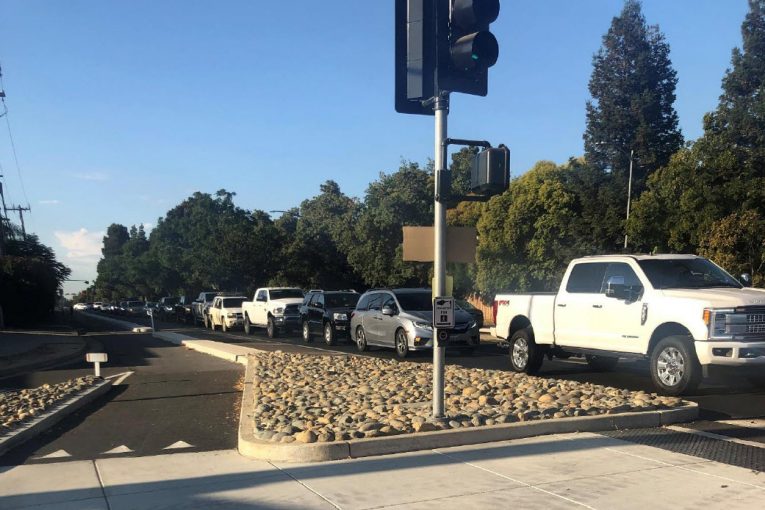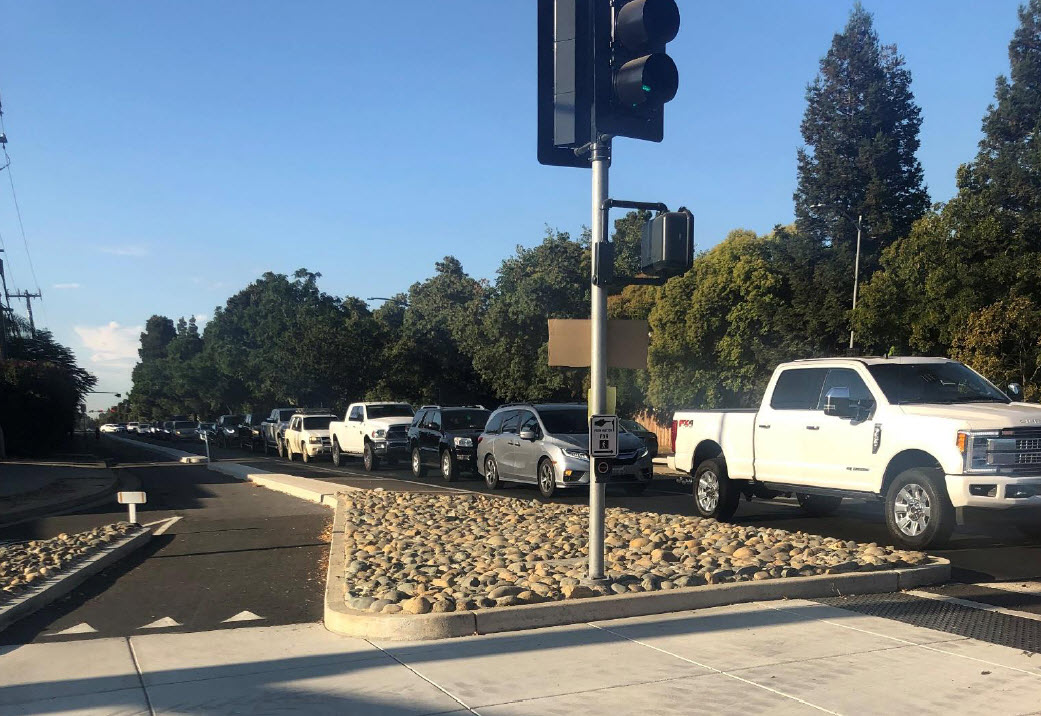

Staff will be looking for direction from council as to what alternative to move forward with in redesigning Mace Boulevard after a series of public hearings in which at least the boisterous portion of the South Davis residents argued and sometimes pleaded with the city to put the road back to the way it was prior to changes.
Among the concerns expressed by the community over the last six to nine months has been “significant delays in traveling along the Mace corridor at peak times,” “the ability for the Fire Department to respond to calls now that travel south of the Fire Station is reduced to one lane and there is a hard curb that prevents vehicles from moving over to allow emergency vehicles to pass, the reduction of “vehicle travel lanes from two to one along the corridor,” among other factors.
There have also been concerns about the tight turning radius at the corners of Cowell and Mace as well as the lack of a multi-way stop at Mace and San Marino.
Among potential solutions that have been identified: restore second northbound lane, restore second southbound lane, second left turn lane for northbound Mace to westbound Cowell, dedicated right turn for northbound Mace to eastbound Cowell, widen shared use path on the east side of Mace to support two-way bike traffic, and meter northbound Mace traffic at Montgomery during peak times.
The Davis Police have noted that vehicles are using the center turn lane between San Marino and North El Macero “to pass queued vehicles in the northbound travel lane.” This has caused some “concern for public safety.”
Staff writes, “Because of this, engineering staff recently hired a contractor to restripe this area to have the necessary turn pockets but stripe the remaining area double yellow so that PD can  enforce violations.”
enforce violations.”
As previously noted, one of the problems with the increased traffic has been “navigation apps like Waze have provided drivers with driving directions based on real-time traffic updates and alternative routes to traditional corridors in an effort to avoid congested roadways.
“These navigation apps are diverting I-80 traffic onto surface streets, resulting in commuters overburdening and creating congestion impacts on surface streets in the City at the expense of residents.”
This has led some to ask the city to look into whether they can launch legal action against Waze or limit road usage to local residents, thereby closing the roads to commuters.
Unfortunately, staff writes that under the Vehicle Code, the city lacks authority over “vehicular traffic control except as expressly provided and the statutory authority to prescribe traffic rules has been strictly construed.” People have the right to use public roads and the city, therefore, “may not restrict the right to travel upon its streets to residents, or to other exempted drivers, and exclude all other drivers, such as non-resident commuters.”

Staff adds that they “are deciding to take alternative roadways to avoid congestion on traditional arteries. As a result, the City has not identified legal grounds to form a basis to sue navigation apps like Waze for their role in directing traffic onto roads in the City previously used less by commuters.”
The best solution then is to implement policies that slow traffic down in the southern portion of Mace, which could impact the algorithms used by the navigational apps and stop the apps from diverting traffic from I-80 to Mace.
A less understood impact has been that the increase in wait time for on-ramp metering lights has impacted the congestion along Mace. As a result, staff has reached out to Caltrans and they have “agreed to look at the options for the on-ramps at Mace to determine what could be done to assist the corridor.”
Fehr & Peers found “benefits to the recommended solution of adding metering to the HOV lane” and recommend that the city pursue SACOG (Sacramento Area Council of Governments) funding to help design it.
In their overall analysis, Fehr & Peers found, “When I-80 is congested, vehicles divert onto local cut through routes, including Mace Blvd.” This causes the traffic on Mace Blvd. that is going northbound to queue back south of I-80 toward Montgomery Ave.
A few weeks ago, when consultant Adrian Engel from Fehr & Peers presented to residents of South Davis at Pioneer Elementary, he presented three primary improvement strategies.
The first is new traffic signals along the corridor that can “help meter some of the traffic that’s coming from the south and create gaps in that traffic,” and “it can help control the flow so you can monitor the flow in a progression through some of the intersections.”
He suggested that a series of signals would help control the flow, just as what exists along other corridors off the freeway but is lacking at Mace.
“Additional signals can help that without having to add capacity,” he said.
The second improvement is “adding lanes back to the roadway that were previously taken away.”
He pointed out that this will “allow some of the local traffic to bypass the queue to be able to get around some of the traffic.” He warned that by creating additional capacity, “it could induce people to leave 80 at Dixon and drive into this community.”
He warned that could mean, instead of 200 cars, there could be 400 cars because I-80 hasn’t gotten better yet and there would be additional capacity on this road.
Finally he suggested adding ramp meters to the HOV (high occupancy vehicle) bypass lane at the freeway on-ramp. Right now, he said, half of the cars jump over to the HOV lane to bypass the traffic signal because they’ve been sitting on Mace for 35 minutes and calculate it is unlikely they will be caught and ticketed.
“As they do that they are entering the freeway faster than what the meter would normally allow which then creates congestion and back up on the freeway.” He said that creates additional congestion and increases people bypassing I-80.
Caltrans estimates that by doing that they could save one to three minutes on I-80, thereby reducing the amount of time lost by staying on the freeway.
The next steps would be to hold a community open house at the 30 percent design point, which would also include projected construction costs. And they will then return to council for review following that meeting to get further direction on moving forward with the final design, as well as identifying funding for construction.
—David M. Greenwald reporting


The city is not going to be able to fix this problem.
Always the optimist.
The problem is I-80. Just drive at 4 pm today and head south on Mace from Covell. There is no redesign there and yet it will take you a half hour.
Or, the problem may lie in driving @ 4 PM… the two are related, but can be independent…
I take the train.
This describes what the City can do. Can Yolo County do something? Can Dixon and Solano County also do something?